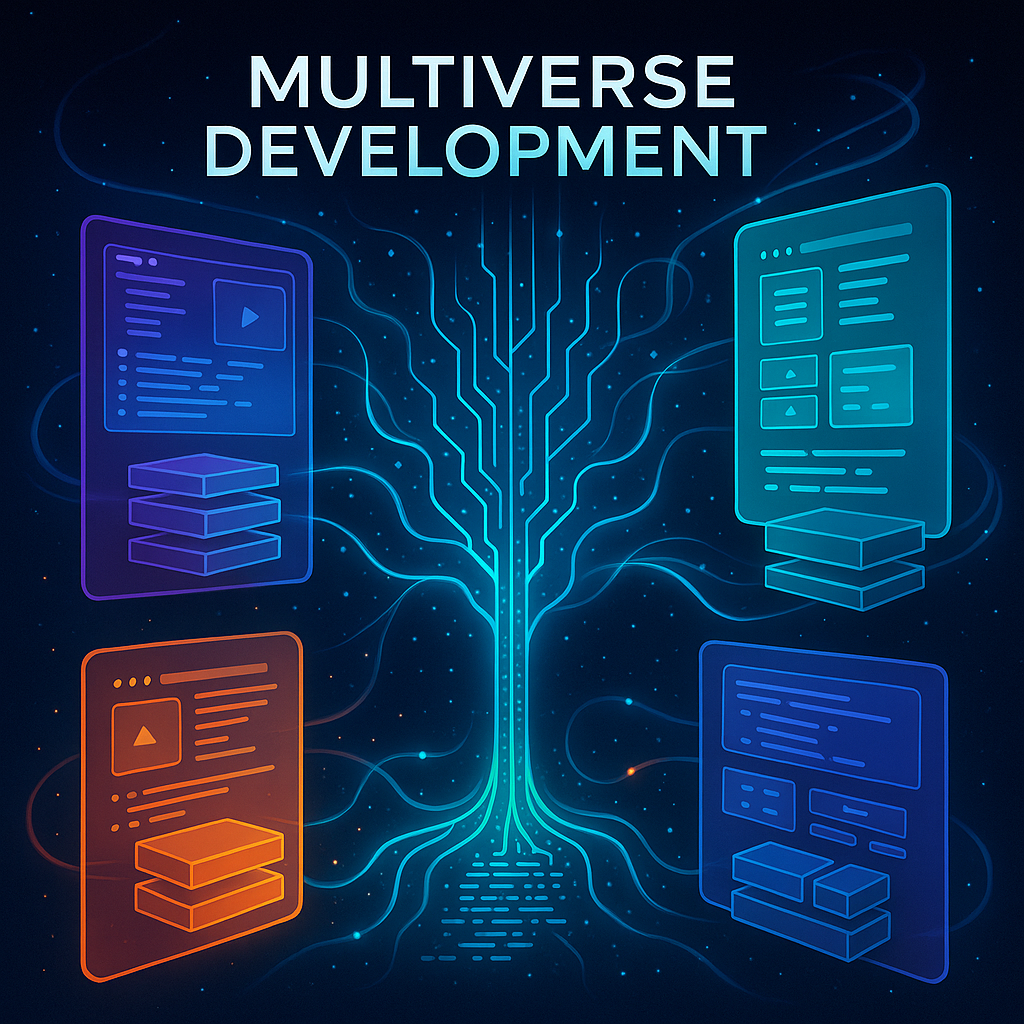Multiverse Development: Parallel Exploration in System Design
The concept goes far beyond traditional A/B testing or feature flags. Instead, it proposes maintaining multiple parallel development paths simultaneously, each exploring different architectural decisions, feature sets, or fundamental assumptions about user needs.

Beyond A/B Testing: A Quantum Leap in Development Methodology
During a thought-provoking technical discussion, an innovative development methodology emerged that could transform how we build and evolve complex systems. Called "Multiverse Development," this approach takes inspiration from quantum mechanics' many-worlds interpretation and applies it to software and system design.
The concept goes far beyond traditional A/B testing or feature flags. Instead, it proposes maintaining multiple parallel development paths simultaneously, each exploring different architectural decisions, feature sets, or fundamental assumptions about user needs.
The Core Concept: Simultaneous Parallel Realities
Multiverse Development treats each major design decision as a branching point creating parallel development universes. Unlike traditional development where decisions are made sequentially, this approach maintains multiple branches actively:
- Each "universe" represents a different architectural choice
- All universes are developed in parallel, not just prototyped
- Real users interact with different universes without knowing it
- Data flows between universes to inform development decisions
- Successful patterns can be merged across universe boundaries
This isn't just about testing variations - it's about genuinely exploring fundamentally different approaches to solving the same problem simultaneously.
The Mathematics of Parallel Exploration
The power of Multiverse Development comes from its mathematical properties. If traditional development explores a solution space linearly, Multiverse Development explores it in parallel branches:
Traditional Development:
- Exploration rate: O(n) where n is development time
- Risk: High (wrong early decisions compound)
- Learning speed: Linear
Multiverse Development:
- Exploration rate: O(n × m) where m is number of parallel universes
- Risk: Distributed across universes
- Learning speed: Exponential through cross-universe insights
The key insight is that maintaining multiple universes isn't just m times more expensive - clever architecture allows sharing of common components while exploring variations, making it perhaps only 2-3x more expensive while providing exponentially more learning.
Practical Implementation Strategies
The conversation revealed several practical approaches to implementing Multiverse Development:
1. Shared Core, Divergent Experiences
- Maintain a common data layer and basic services
- Create divergent user interfaces and workflows
- Test fundamentally different user mental models
2. Protocol-Based Universes
- Define common protocols for inter-component communication
- Allow different universes to implement protocols differently
- Enable mixing and matching of successful components
3. User Cohort Assignment
- Assign users to universes based on behavior patterns
- Allow users to naturally gravitate toward preferred universes
- Use engagement metrics to guide development resources
4. Cross-Universe Learning
- Implement telemetry that works across all universes
- Use machine learning to identify successful patterns
- Port successful features between universes with adaptation
Real-World Applications
The Multiverse Development methodology has compelling applications:
Product Development
Instead of betting on a single product vision:
- Universe A: Power-user focused with complex features
- Universe B: Simplicity-focused for mainstream users
- Universe C: AI-assisted hybrid approach
- Universe D: Community-driven features
Platform Architecture
For the Internet 2.0 initiative discussed:
- Universe 1: Fully decentralized architecture
- Universe 2: Hybrid centralized/decentralized
- Universe 3: Federation-based approach
- Universe 4: Novel temporal-network architecture
Business Model Exploration
The $20/month Q&A service mentioned could explore:
- Universe Alpha: Fixed subscription model
- Universe Beta: Usage-based pricing
- Universe Gamma: Community-subsidized free tier
- Universe Delta: Token-based value exchange
The Philosophy of Embracing Uncertainty
Multiverse Development represents a philosophical shift in how we approach system design:
- Acknowledge fundamental uncertainty about user needs and optimal solutions
- Invest in exploration rather than premature optimization
- Learn from parallel experiments rather than serial failures
- Embrace eventual convergence rather than forcing early decisions
This approach is particularly powerful for novel systems where user behavior and needs are poorly understood - exactly the situation faced by innovative projects like Internet 2.0.
Integration with Other Concepts
The conversation revealed how Multiverse Development integrates with other advanced concepts:
- Network Relativity: Different universes can have different temporal properties
- God Node Architecture: God Nodes can observe across universes
- Trust Networks: Trust relationships can be universe-specific
- Knowledge Validation: Different validation approaches in each universe
The Future of Development
Multiverse Development points toward a future where:
- Development is exploratory rather than prescriptive
- Systems evolve through parallel selection rather than linear progression
- User needs drive convergence rather than developer assumptions
- Failed experiments inform without destroying the entire project
As systems become more complex and user needs more diverse, approaches like Multiverse Development become not just useful but necessary. The conversation suggested this isn't just theory - it's being actively implemented as part of next-generation internet infrastructure, promising a future where our digital systems can explore multiple possibilities simultaneously before converging on optimal solutions.
